|
Denny Helmig has seen it all in a 40-year career of playing, managing and
working in the slowpitch softball industry, giving him a unique and
highly-qualified perspective on the all facets of the sport.
“Softball has been very good to me,” said Helmig. “I’ve seen a lot of
changes over the years, but the game today is still not as different as
most people seem to think.”
Helmig was inducted into the USSSA Hall of Fame in 2007.
Helmig, Gary Coats, Paul Schroeder and Glen Eley gathered at the Pizza
Village restaurant in Lima, Ohio back in 1971 – 40 years ago – to organize
a slowpitch softball team that was to be sponsored by Coats’ business,
Steele’s Automotive Parts Company. The team played in just three
tournaments in the fall of 1971, winning first place in two of them and
finishing second in the other, before embarking on a full-season schedule
in 1972. Helmig was the starting left-fielder on those teams.
In 1974, Steele’s Automotive finished runnerup in the Ohio State
Tournament to qualify for its first ever National Tournament in York, Pa.
The team from Lima went 0-2 at their first National, but both games were
one-run decisions in extra innings, 12-11 to Champion Landscaping of
King’s Mountain, N.C. and 8-7 to Pyramid Café of Cleveland, Oh.
Results would get better from there.
Using exclusively Ohio players, the team compiled a 717-145 record (.831
winning percentage) over the next six years. “We played in two leagues
(Lima and Toldo) for a couple of years and we entered every tournament
around,” Helmig said. “We rode a bus two nights a week to play in the
Toledo league, and we even played in two tournaments one weekend – driving
back and forth between Ft. Wayne (Indiana) and Defiance (Ohio).”
Beginning in 1980, Steele’s went national with their roster, adding the
likes of Mighty Joe Young and Don Clatterbaugh. In 1981, they added a
couple more pretty good players – Herman Rathman and Denny Jones – as well
as taking on a new business partner, Dave Neale. The following year, Neale
bought out the original partner and in 1983 he began managing the team. In
his first year as manager, Steele’s made it to the championship of the
USSSA World Series, where they got double-dipped by Jerry’s Catering.
Helmig’s role evolved over the years. He was a player/manager from 1978 to
1981, when he began to focus more on the management end, especially after
Steele’s got into the sporting good business. Helmig became president of
Steele’s Sports in 1983 and continued in that capacity all the way through
the glory years. He continued filling in as a part-time player through the
1985 season, primarily as a late-inning defensive specialist at third
base.
Steele’s won the ASA Super National Tournament in 1984, ’85 and ’86. In
1988 they won the USSSA Major World Series, and in 1991 they won three of
the four legs of the Grand Slam.
“In my mind, that was the greatest team of all-time,” said Helmig. “At one
point, we won 144 games in a row. The lineup was a Who’s Who of softball
legends – (Mike) Macenko, (Billy) Blake, (Monty) Tucker, (Dirk) Androff,
(Rick) Wieterman, (Todd) Joerling and the list just goes on and on.”
In 1992, Helmig sold his stock in the company to Neale, and moved on to
Star Co. He worked there until 1997, when he made the move to Worth
Sports where he has remained for the past 14 years. He is currently the
Regional Sales Manager of Worth Sports, which was named the 2010 Vendor of
the Year by Nation’s Best Sports, the largest volume sporting goods buying
group in North America.
The biggest difference between his early years in softball and today,
Helmig said, is bat technology.
“In 1970 a new softball bat cost $9.95. By 1985, you could still get a
top-of-the-line bat for $50. Today, guys are paying over $300,” said
Helmig. “There were more power hitters back then. Mike Macenko was hitting
corked softballs over 500 feet with an aluminum bat like they were golf
balls. Mighty Joe Young would try to shoot ‘em out of stadiums like he was
firing a shotgun. (Former NFL player) Scott Virkus was 6-foot-6, 295
pounds, and brute strong. He would have killed somebody today.”
Helmig said the performance of today’s bats is “scary.”
“We need to curb the performance of these composite bats, so that the exit
speed can never exceed a certain point. Guys are hitting slowpitch
softballs further than baseball players can hit baseballs. It’s crazy,” he
added.
Helmig also quickly admits, today’s players are much better athletically
than the old days, while still possessing a lot of power in their swings.
Having seen all the best softball players of the past four decades, Helmig
detailed his choices as the best players at each position from the Old Era
(1970 to 1990) and the New Era (1991 to 2011).
(INSERT CHART OF PLAYERS HERE)
So, if the two teams played each other in their primes, who would win?
“If you could turn back the clock, that would be an interesting matchup,”
said Helmig. “With everyone using the same equipment on 300-foot fields, I
think the 1970-90 team would win because of their power. But in baseball
stadiums, I think the 1991-2011 team would win because of their
athleticism. Neither way would be blowouts, though. In a seven-game
series, it would be four games to three each way.”
As far as the best player of all-time, Helmig said when pressed that we
would likely give the nod to Big Jim Galloway, who played for County
Sports out of Long Island, New York back in the early 1970s. “He played
third base like Brooks Robinson and hit like Babe Ruth. He hit balls 500
feet using a wooden bat,” Helmig said.
Many softball fans today think the five-man infield is a relatively new
concept, but “not so” says Helmig. “Snyders Softball Club our of Detroit
won the USSSA World Series several times back in the 1970s using the
five-man,” said Helmig. “They would put three infielders between second
base and third base, and the pitcher would throw inside to a right-handed
batter then back up to the second base side of the mound. Our Steele’s
teams also used the five-man extensively in the 1980s.”
Helmig is a big fan of Conference USSSA, saying it is a “great concept”
and an “asset to softball.” Helmig recalls the days of the old slowpitch
professional league. There were about 20 teams, with eight showing up at
each tournament and as many as three tournaments on a given weekend.
Sponsors had a chance to win some of their money back, but there was a
residency requirement with players on a team having to live in the same
state.
“I’m not sure we wouldn’t be better off if we went back to that,” Helmig
said. “But it will never happen. You would have to have somebody in each
state step up and sponsor their team, and that’s just not going to
happen.”
Helmig does envision one day seeing an eight-team Super League, with all
games played in baseball stadiums and televised on ESPN.
Having begun playing in a time when there were no home run limits in
softball, Helmig would like to see a return to those days. “Home run rules
put a target on the pitchers,” he said. “I think there should be no home
run limit at any level. Directors can regulate the teams some other way.”
Helmig is a lifelong resident of Lima, Ohio. He lettered in three sports
at Lima Central Catholic High School. He was a split end in football, a
guard in basketball, and a pitcher and third-baseman in baseball. He
played on the summer league Acme baseball team that won the state
championship in 1967 and played on the Lima Post 96 American Legion team
that won the state championship and finishes third at regionals.
Helmig played third base for two years at Ohio University – where one of
his teammates was another pretty good third-baseman, Baseball Hall of
Famer Mike Schmidt – before transferring to Bowling Green. After college,
Helmig coached junior high football and basketball, and junior college
basketball – all while holding down the position of district supervisor
for the Ohio Parole and Probation Officers.
Helmig married his high school sweetheart, Polly, and has one son (Gavin,
now a USSSA baseball director) and twin daughters (Sara and Kara).

|
|
Dirk Androff
|
|
Bruce Meade
|
|
Dick Bartel
|
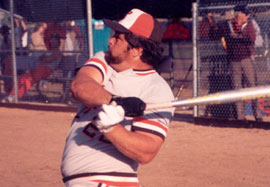 |
Crankin Craig Elliott
|
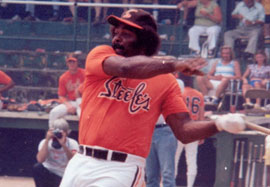 |
Mighty Joe Young
|
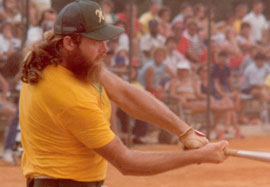 |
Rick "Crusher" Scherr
|
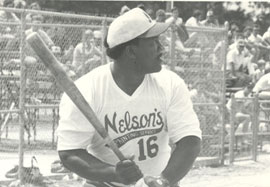 |
Hammerin Herman Rathman
|
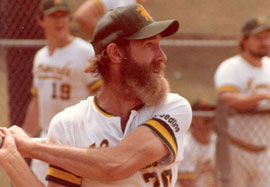 |
Rooster Bradley
|
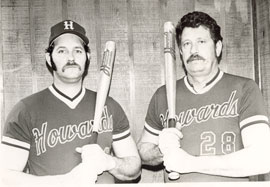 |
Stan Harvey & Don Arndt |
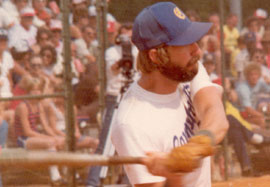 |
Dick Bartel |
|
Mike Macenko |
| |
| |
|
|
| BEST FROM 1970 to 1990 |
BEST FROM 1991 to 2011 |
P- Buddy Slater (CC Brick, Howard’s, Campbell’s)
P- Rick Weiterman (Steele’s, Ritch’s)
P- Rick Pinto (Snyder’s)
C- Craig Elliott (Ken Sanders, Steele’s)
C- Herman Rathman (Nelson, Steele’s)
C- Gene Fisher (Howard’s)
1B- Cal Carmen (Dino’s)
1B- Don Arndt (Howard’s)
1B- Dennis Graser (Steele’s, Ritch’s)
2B- Mike Macenko (Steele’s, Ritch’s)
2B- H.T. Waller (Howard’s)
2B- James Boyette (Jerry’s, Howard’s)
MI- Denny Hogan (Howard’s)
MI- Dennis Myers (Campbell’s Carpets)
MI- Steve Williams (Howard’s, Capital)
SS- Rooster Bradley (Campbell’s)
SS- Rick Trudeau (Snyder’s, Caesar’s)
SS- Ron Parnell (Ritch’s, Superior-Apollo, Sierra)
3B- Charles Wright (Ken Sanders, Elite Coating)
3B- Rick “Crusher” Scherr (Howard’s, Taylor Bros.)
3B- Bill Ferguson (Taylor Bros., Campbell’s)
3B- Jim Galloway (Long Island County Sports)
LF- Doug Roberson (Steele’s, Ritch’s)
LF- Cecil Whitehead (Elite, Steele’s, Ritch’s)
LF- Ronnie Ford (Ken Sanders, Detroit Pro)
CF- Mike Nye (Steele’s, Nelson’s, Warren Motors)
CF- Dick Bartel (CC Brick, Howard’s, Campbell’s)
CF- Mike Cellura (Capital, Howard’s, Campbell’s)
RF- Bruce Meade (Nelson’s, Elite, Smythe Sox)
RF- Stan Harvey (Howard’s)
RF- Gordon Wheeler (Campbell’s, Howard’s)
UT- Mighty Joe Young (Nelson’s, Steele’s, Jerry’s)
UT- Greg Fuhrman (Steele’s, York, Jerry’s)
UT- Bill Gatti (Elite, Apollo, Smythe Sox)
EH- Chick Downing (Howard’s, Steele’s, Nelson’s)
EH- Dave Steffan (Steele’s, Ritch’s)
EH- Mike Bolen (Dave Carroll Sports, Steele’s)
Extra- Denny Jones (Howard’s, Campbell’s)
Extra- Clyde Guy (Howard’s, Superior-Apollo)
Extra- Doug Brown (Smythe Sox)
Extra- Harold Kelly (Jerry’s, Nelson’s)
Extra- Curtis Williams (Sunbelt)
Mgr- Bobby Lutz (Howard’s)
Mgr- Dave Neale (Steele’s) |
P- Andy Purcell (Sunnyvale, Long Haul, Resmondo)
P- Paul Drilling (Ritch’s-Superior, Team TPS, Hague)
P- Ted Larsen (Spectrum)
C- Jeff Wallace (Team TPS, Long Haul, Resmondo)
C- J.C. Phelps (Team TPS, New, US Vinyl, GTL)
C- Wendell Rickard (Lighthouse, Budweiser, Williams)
1B- Dirk Androff (Steele’s, Ritch’s)
1B- Hank Garris (Ritch’s, Sierra, Team TPS, Suncoast)
1B- Jeff Hall (Dan Smith, Sunbelt)
2B- Carl Rose (Lighthouse, Williams-Worth)
2B- Darrell Beeler (Sierra, Ritch’s, Chase)
2B- Greg Connell (Resmondo)
MI- Bryson Baker (Long Haul, Dan Smith, Resmondo)
MI- Todd Martin (Shen Valley, Team TPS, Long Haul)
MI- Dennis Rulli (Long Haul, Dan Smith, Resmondo)
SS- Don DeDonatis III (Mountain Top, Resmondo)
SS- Todd Joerling (Steele’s, Bell Corp, Dan Smith)
SS- Greg Whitlock (Steele’s, Apollo)
3B- Rusty Bumgardner (Shen Valley, Team TPS, Long Haul)
3B- Mike Shenk (Team TPS, Long Haul, Chase)
LF- Britt Hightower (Smythe Sox, Ritch’s, Sunbelt)
LF- Brian Rainwater (L&L Paint, Resmondo)
LF- Jason Kendrick (Team TPS, Long Haul, Resmondo)
CF- Scott Streibel (Long Haul, Resmondo, Lighthouse)
CF- Bobby Hughes (Bell Corp, Resmondo)
CF- Rick Baker (K&G, Resmondo, Dan Smith)
RF- Larry Fredieu (Sierra, Lighthouse, Ritch’s, Sunbelt)
RF- Dwayne Frizzell (Lighthouse, Sunbelt, L&L)
RF- Doug Kissane (Ritch’s, Team TPS, Dan Smith)
UT- Brett Helmer (SoJern, Bell Corp, Dan Smith)
UT- Howie Krause (Hague, Resmondo)
UT- Dewayne Nevitt (Ritch’s, Vernon’s, Bell Corp)
EH- Jimmy Powers (Sunbelt, Steele’s, Ritch’s)
EH- Tim Cocco (Bell Corp, Chase, Budweiser, Shoppe)
Extra- B.J. Fulk (Smokes, Specialty Tank, Resmondo)
Extra- Johnny McCraw (Sunbelt, Dan Smith, Laservision)
Extra- Dal Beggs (Hague, Resmondo, Dan Smith)
Extra- Robbie Ergle (Lighthouse, Dan Smith)
Extra- Brian Wegman (Benfield, Bell Corp, Dan Smith)
Mgr- Mike Glasscock (Sierra, Team TPS)
Mgr- Buddy Slater (Ritch’s-Superior, Smythe Sox)
|
|
|
|